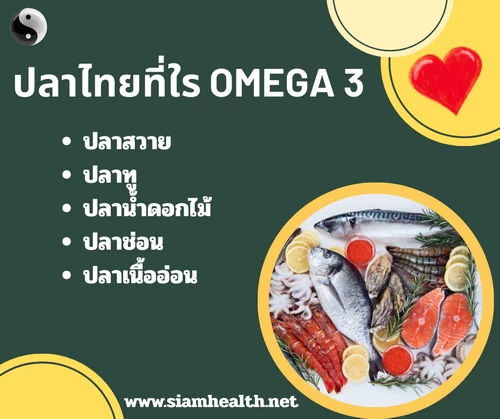ปลาไทยและปลาต่างประเทศที่มีโอเมก้า 3 สูง 10 ชนิด
โอเมก้า 3 เป็นกรดไขมันไม่อิ่มตัวที่ร่างกายไม่สามารถสร้างเองได้ และมีความสำคัญต่อสุขภาพหัวใจ สมอง และระบบประสาท แม้ว่าปลาทะเลน้ำลึกจากต่างประเทศอย่างแซลมอนมักถูกพูดถึงในฐานะแหล่งโอเมก้า 3 ชั้นนำ แต่ปลาไทยทั้งน้ำจืดและน้ำเค็มก็มีปริมาณโอเมก้า 3 ที่น่าสนใจไม่แพ้กัน ต่อไปนี้เป็นรายชื่อ 10 ชนิดของปลาไทยและปลาต่างประเทศที่มีโอเมก้า 3 สูง รวมถึงประโยชน์และวิธีการบริโภคเพื่อสุขภาพที่ดี
ปลาไทยที่มีโอเมก้า 3 สูง 10 ชนิด(มิลิกรัมต่อเนื้อปลา100กรัม)
- ปลาสวาย - มีโอเมก้า 3 ประมาณ 2,111 มิลลิกรัม ปลาน้ำจืดที่อุดมไปด้วยไขมันดี เหมาะสำหรับเมนูปลาสวายรมควันหรือต้มยำ
- ปลาทู - มีโอเมก้า 3 ประมาณ 1,636 มิลลิกรัม ปลาทะเลไทยที่หาง่าย ควรนึ่งหรือต้มเพื่อคงคุณค่า
- ปลาช่อน - มีโอเมก้า 3 ประมาณ 870 มิลลิกรัม ปลาน้ำจืดรสชาติดี นิยมทำปลาช่อนลุยสวน
- ปลากะพงขาว - มีโอเมก้า 3 ประมาณ 400 มิลลิกรัม เนื้อนุ่ม เหมาะกับการนึ่งมะนาว
- ปลาสำลี - มีโอเมก้า 3 ประมาณ 470 มิลลิกรัม ปลาทะเลที่นิยมทอดหรือทำสามรส
- ปลาจะละเม็ด - มีโอเมก้า 3 ประมาณ 840 มิลลิกรัม ปลาทะเลขนาดเล็ก เหมาะกับการนึ่ง
- ปลาดุก - มีโอเมก้า 3 ประมาณ 460 มิลลิกรัม ปลาน้ำจืดที่นิยมทำยำปลาดุกฟู
- ปลาสลิด - มีโอเมก้า 3 ประมาณ 360 มิลลิกรัม ปลาน้ำจืดที่ทำเป็นปลาแห้งได้รสชาติดี
- ปลาตะเพียน - มีโอเมก้า 3 ประมาณ 240 มิลลิกรัม เหมาะกับการต้มหรือทอด
- ปลาอินทรี - มีโอเมก้า 3 ประมาณ 330 มิลลิกรัม ปลาทะเลที่อุดมด้วยโปรตีนและไขมันดี
ปลาต่างประเทศที่มีโอเมก้า 3 สูง 10 ชนิด(มิลิกรัมต่อเนื้อปลา100กรัม)
- ปลาแซลมอน - มีโอเมก้า 3 ประมาณ 1,000-1,700 มิลลิกรัม ปลาน้ำลึกที่ช่วยบำรุงสมอง
- ปลาแมคเคอเรล - มีโอเมก้า 3 ประมาณ 2,300 มิลลิกรัม อุดมด้วยวิตามิน D
- ปลาทูน่า - มีโอเมก้า 3 ประมาณ 1,200 มิลลิกรัม เหมาะกับสลัดหรือซาซิมิ
- ปลาซาร์ดีน - มีโอเมก้า 3 ประมาณ 1,000 มิลลิกรัม ปลาขนาดเล็กที่กินทั้งกระดูกได้
- ปลาแอนโชวี่ - มีโอเมก้า 3 ประมาณ 2,000 มิลลิกรัม ใช้ทำน้ำปลาหรือซอส
- ปลาเฮอร์ริ่ง - มีโอเมก้า 3 ประมาณ 1,800 มิลลิกรัม ปลาน้ำลึกจากยุโรป
- ปลาค็อด - มีโอเมก้า 3 ประมาณ 900 มิลลิกรัม ใช้ทำน้ำมันตับปลา
- ปลาเทราต์ - มีโอเมก้า 3 ประมาณ 1,500 มิลลิกรัม ปลาน้ำจืดจากต่างประเทศ
- ปลาซาบะ - มีโอเมก้า 3 ประมาณ 1,900 มิลลิกรัม ปลาทะเลญี่ปุ่นยอดนิยม
- ปลาพอลล็อก - มีโอเมก้า 3 ประมาณ 800 มิลลิกรัม ใช้ทำปลาแช่แข็ง
ประโยชน์ของโอเมก้า 3
- บำรุงสมองและระบบประสาท - ช่วยพัฒนาความจำและการเรียนรู้ โดยเฉพาะในเด็กและผู้สูงอายุ
- สุขภาพหัวใจ - ลดระดับไตรกลีเซอไรด์และป้องกันการอุดตันของหลอดเลือด
- ต้านการอักเสบ - ช่วยลดอาการของโรคข้อและผิวหนัง
- พัฒนาการของทารก - ส่งเสริมการมองเห็นและระบบประสาทในช่วงตั้งครรภ์
เคล็ดลับการบริโภคปลาเพื่อได้รับโอเมก้า 3 สูงสุด
- เลือกวิธีปรุงที่เหมาะสม - ควรนึ่ง ต้ม หรืออบ เพื่อป้องกันการสูญเสียโอเมก้า 3 จากความร้อนสูงของการทอด
- หลีกเลี่ยงปลาที่ปนเปื้อน - ปลาทะเลบางชนิดอาจมีสารปรอท เลือกจากแหล่งที่เชื่อถือได้
- รับประทานสลับกัน - เปลี่ยนชนิดปลาเพื่อความหลากหลายของสารอาหาร
- ปริมาณที่แนะนำ - องค์การอนามัยโลกแนะนำรับประทานปลา 1-2 มื้อต่อสัปดาห์ หรือได้โอเมก้า 3 ประมาณ 200-500 มิลลิกรัมต่อวัน
ข้อควรระวัง
- ผู้ที่มีปัญหาการแข็งตัวของเลือดควรปรึกษาแพทย์ก่อนบริโภคในปริมาณมาก
- ปลาที่เลี้ยงด้วยอาหารสำเร็จรูปอาจมีโอเมก้า 3 สูงขึ้นแต่ควรตรวจสอบแหล่งที่มา
สรุป
ทั้งปลาไทยและปลาต่างประเทศล้วนเป็นแหล่งโอเมก้า 3 ที่ดีต่อสุขภาพ การเลือกบริโภคให้เหมาะสมกับไลฟ์สไตล์และงบประมาณจะช่วยให้ได้รับประโยชน์สูงสุด โดยเฉพาะปลาไทยที่ราคาเข้าถึงง่ายและมีคุณภาพไม่แพ้ปลานำเข้า หากต้องการข้อมูลเพิ่มเติมเกี่ยวกับการดูแลสุขภาพ ควรปรึกษาผู้เชี่ยวชาญด้านโภชนาการ
เผยแพร่เมื่อ:
โดย: นายแพทย์ ประพันธ์ ปลื้มภาณุภัทร, อายุรแพทย์, แพทย์เวชศาสตร์ครอบครัว




